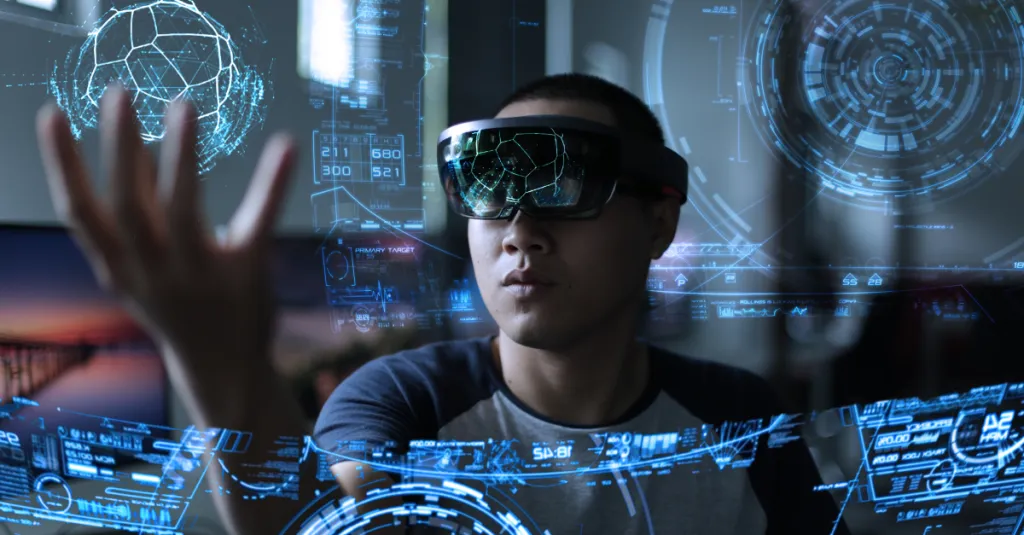The world of Extended Reality (XR) has been evolving rapidly, transforming how we perceive and interact with the digital realm. As we step into 2024, XR is poised for groundbreaking advancements that promise to redefine our daily lives.
In this blog, we’ll explore key XR trends set to shape 2024, including:
- Generative AI
- Mainstream adoption
- Multi-sensory technology
- Social experiences
- Immersive applications beyond gaming
- Wearables
These trends will significantly impact immersive digital experiences, ushering in a new era of technological exploration.
What is Extended Reality (XR)?
Extended Reality (XR) is an umbrella term encompassing immersive technologies that blend physical and virtual worlds. XR includes:
- Virtual Reality (VR): Fully computer-generated environments.
- Augmented Reality (AR): Digital content overlaid onto the real world.
- Mixed Reality (MR): Digital and physical elements coexist and interact in real-time.
XR technologies engage multiple senses, providing heightened presence and interaction. Applications span industries such as gaming, education, and healthcare.
Immersive Experiences Beyond Gaming
While gaming pioneered XR, its impact in 2024 will extend far beyond entertainment:
- Education: Immersive simulations for hands-on learning.
- Healthcare: Realistic medical training to enhance skills and patient care.
- Business: Innovative training programs with realistic scenarios.
- Mental Health: Therapeutic applications for stress relief, anxiety management, and psychological well-being.
Mainstream Adoption: XR for Everyone
In 2024, XR technologies will transition from niche enthusiasts to mainstream adoption, driven by:
- More accessible and affordable XR devices.
- Integration into daily life and diverse industries.
- Enhanced productivity and new approaches to everyday tasks.
Multi-Sensory Tech: Beyond Visuals
XR experiences will increasingly incorporate multiple senses:
- Haptic feedback: Users feel virtual environments through touch.
- Spatial audio: Enhanced perception of depth and directionality.
- Olfactory stimuli: Adding scent to immersive experiences.
This multi-sensory approach will blur the lines between physical and virtual worlds, creating deeper immersion.
Generative AI: Personalized XR Experiences
Generative AI will revolutionize XR by enabling dynamic, personalized content:
- Real-time adaptation to user preferences.
- AI-generated characters and environments responding to interactions.
- Unparalleled personalization, making virtual experiences authentic and responsive.
Social Experiences: XR as Social Hubs
XR platforms will evolve into dynamic social hubs:
- Virtual meetups, conferences, and collaborative workspaces.
- Bridging geographical gaps, fostering community and collaboration.
- Redefining digital interactions and social connectivity.
Wearables: XR in Daily Life
XR wearables, such as AR glasses and MR headsets, will become commonplace:
- Heads-up displays providing real-world context.
- Interactive travel guides and immersive experiences.
- Enhancing daily routines and interactions with digital and physical worlds.
Spatial Computing and 3D Mapping
Spatial computing and advanced 3D mapping will reshape XR experiences:
- Accurate virtual environments for indoor navigation and AR shopping.
- Precise overlays of digital information onto surroundings.
- Enhanced immersive interaction and information overlay.
The Future of XR Gaming: AXIS
Full-body tracking (FBT) will gain popularity in XR gaming, with AXIS leading the way:
- User-friendly, easy setup without technical complexity.
- Wireless charging, dust and water resistance for durability.
- Up to 16 interchangeable nodes and 9 degrees of freedom for precise motion tracking.
AXIS will significantly enhance immersive gaming experiences, driving XR gaming forward in 2024.
